15 Types of BLACK And RED BIRDS (ID Guide With Photos)
Did you recently come across a black and red bird, and want to know what species it was?
Identifying birds that have both black and red plumage is not as easy as it might seem, since there are surprisingly many birds in North America that fit this description.
To help you identify the bird you saw, we’ll cover all the black and red birds of North America.
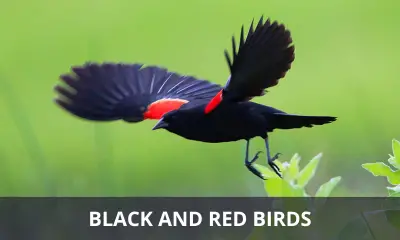
What types of birds are black and red?
There are 15 types of birds that are red and black in North America, which are covered in full detail below.
Northern Cardinal
Scientific name: Cardinalis cardinalis
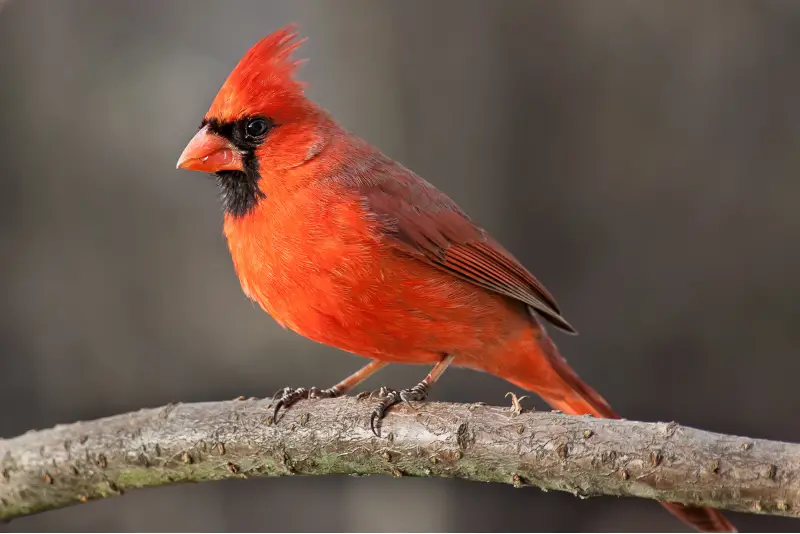
As the state bird of no less than seven US states, the Northern Cardinal is the most well known red bird of North America.
Male Northern Cardinals have a bright crimson coloration on their head, chest, and belly, and slightly darker plumage on their back and wing feathers.
In addition, their face has a black mask extending from the brightly colored bill to the throat.
The Northern Cardinal is a common bird in large parts of the eastern United States, and can be seen year round in backyards, gardens, small forests, and parks.
Scarlet Tanager
Scientific name: Piranga olivacea
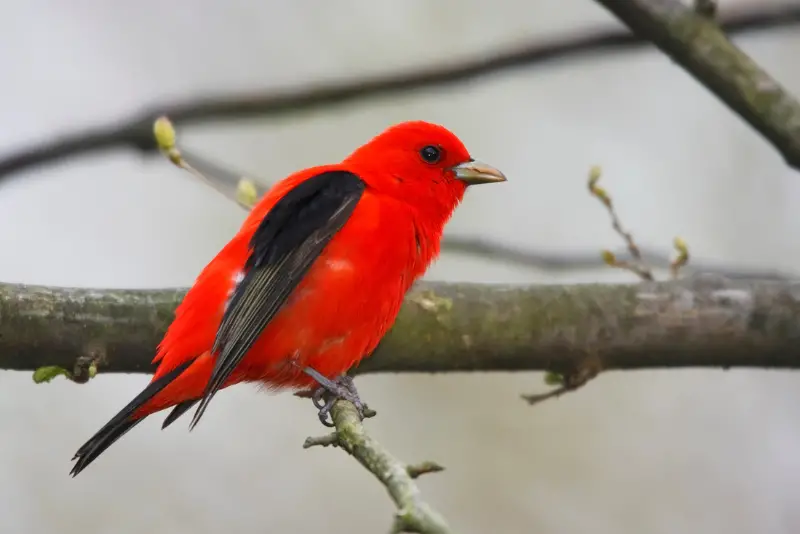
The Scarlet Tanager is a bird with a tropical appearance, due to the bright scarlet plumage of the males, which contrasts with their coal-black wings and tail feathers.
But unlike the startling bright color of the male, the female looks more like a small yellow bird.
This bird is a summer visitor to North America, and spends its winter in Central and South America.
Both sexes sing a similar song in order to mark and defend their territory from other tanagers.
These birds are insectivores, and feed on spiders and flying insects (including bees and wasps) high up in tree canopies.
Vermilion Flycatcher
Scientific name: Pyrocephalus obscurus
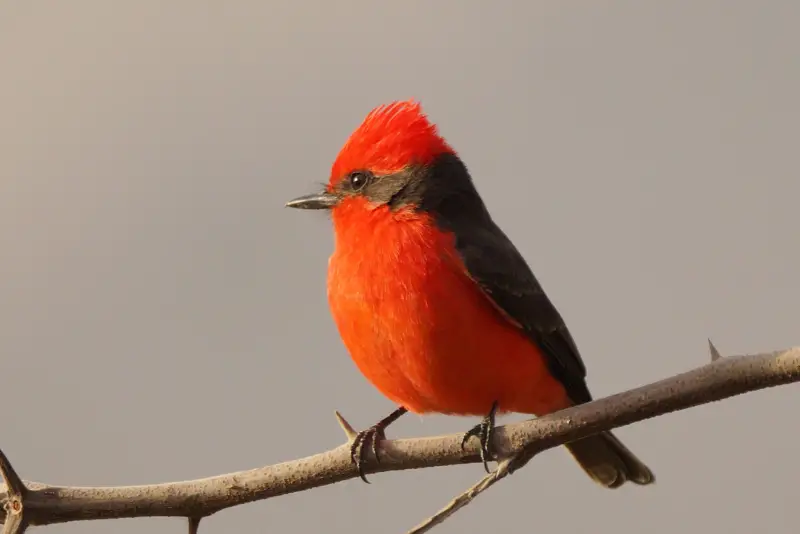
The Vermilion Flycatcher is one of the most beautiful songbirds that can be seen in North America.
Adult males have a bright crimson underside, throat, and crown, while the rest of their body is black.
Females and immatures, on the other hand, are grayish brown on top, and pale underparts.
It is a strict migratory bird, with most Vermilion Flycatchers migrating to Central America to spend the winter, with only a handful of individuals remaining in North America during the cold season.
The preferred habitat of the Vermilion Flycatcher is open woodland and parks in areas close to water.
Red-winged Blackbird
Scientific name: Agelaius phoeniceus

The Red-winged Blackbird is one the most abundant birds in North America, and is found in all US states as well as in large parts of Canada.
The great thing about these blackbirds is that you can easily distinguish males from females.
Male Red-winged Blackbirds are completely black except for the bright red patches on their wings. In contrast, females (and juveniles) are a blackish brown color with white streaks.
Generally speaking, this blackbird lives in open fields and near water. It is often found in marshes, wetlands, and around lakes.
These blackbirds roost in flocks up to millions of birds strong, creating a deafening noise with their rapidly beating wings.
Red-headed Woodpecker
Scientific name: Melanerpes erythrocephalus
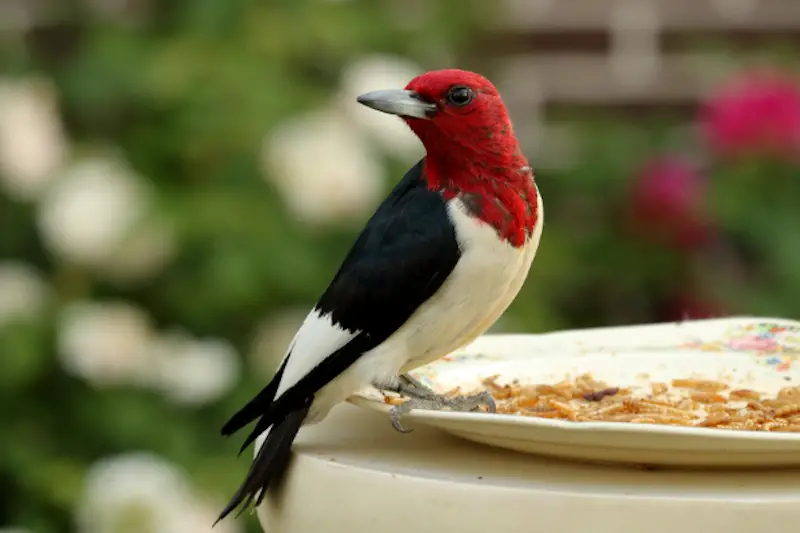
The Red-headed Woodpecker is one of the few non-dimorphic woodpeckers, which means that males and females look alike.
Red-headed Woodpeckers are black and white birds with a red head. While their back is uniformly black, thay have a white chest, rump and belly, as well as black wings and a black tail. The bill and legs are gray.
The Red-headed Woodpecker favors wide-open deciduous or coniferous forest habitats, or forests with plenty of dead or rotten limbs.
It may use the same nest cavity for multiple years in a succession, in contrast to other woodpeckers that only use them once or for a small period of time.
This woodpecker used to be common throughout North America, but the population has unfortunately declined by more than 90 percent, and it is now a rare sight in most areas.
Rose-breasted Grosbeak
Scientific name: Pheucticus ludovicianus
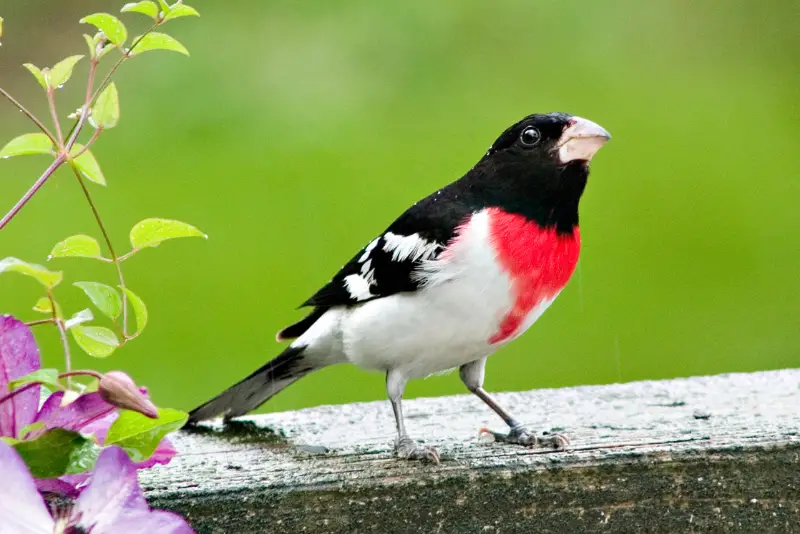
The Rose-breasted Grosbeak is easily identifiable due to its distinct markings and its large beak.
During the summer, adult males have a scarlet chest, which contrasts with their jet black hood and back. Their black wings have white patches and white wing bars.
Adult females and immature birds, on the other hand, have streaked brown plumage that is lighter on the underside than on the back. They also have a white eyebrow stripe and white wingbar.
Rose-breasted Grosbeaks are summer visitors in northern North America from May through August.
This small songbird is migratory, and flies to Central America to spend the winter months. Similar to other crossbill species, it specializes in feeding on the seeds of conifer cones.
Tricolored Blackbird
Scientific name: Agelaius tricolor
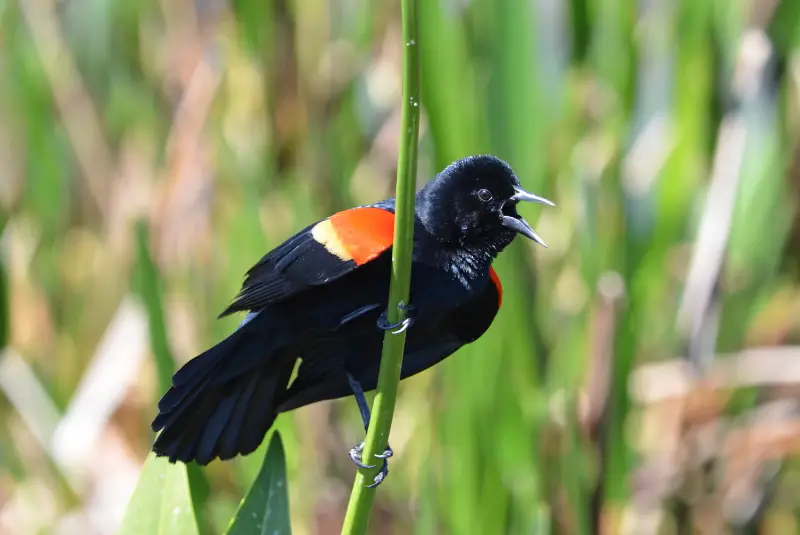
Male Tricolored Blackbirds look superficially similar to Red-winged Blackbirds. Their whole body is iridescent black, except for a small red shoulder patch with a white streak underneath.
They can be distinguished from Red-winged Blackbirds by virtue of their smaller crimson shoulder patch, as well as the broader white line underneath it.
Tricolored Blackbirds used to be very common in California, with flocks that numbered in the millions.
However, due to the extensive destruction of coastal swamps and marshes, they are now an endangered species, with less than forty thousand adults accounting for the entire California population.
Pileated Woodpecker
Scientific name: Dryocopus pileatus
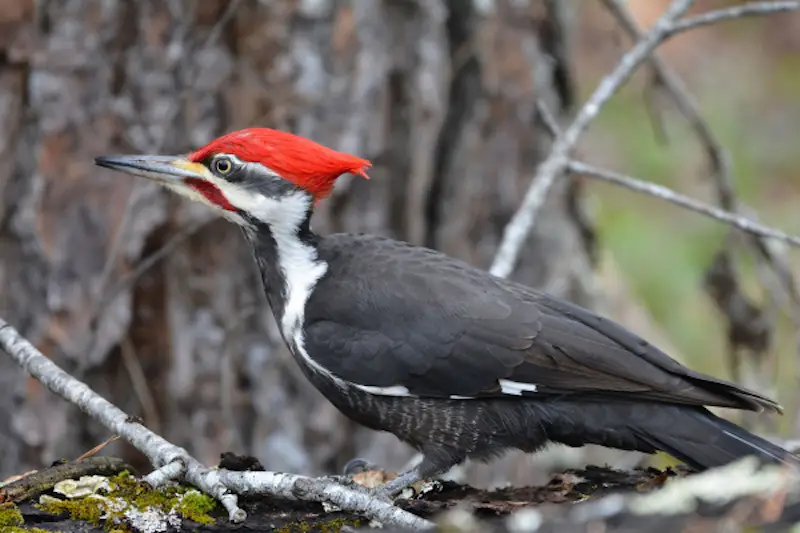
The Pileated Woodpecker is a large, crow sized woodpecker that has a bright red crest and forehead, as well as a black & white striped face and neck
The rest of this bird’s body is mostly black, although the white front edges of the wings flash brightly during flight.
The Pileated Woodpecker is the largest woodpecker in North America, and is a very shy bird that is mostly found in extensive tracts of woodland.
In order to find insects to eat, the Pileated Woodpecker drills oval holes in tree trunks that may be up to several feet long.
You can find large wood chips lying on the ground around its feeding trees, which is a tell-tale sign that Pileated Woodpeckers have been at work.
Red-bellied Woodpecker
Scientific name: Melanerpes carolinus
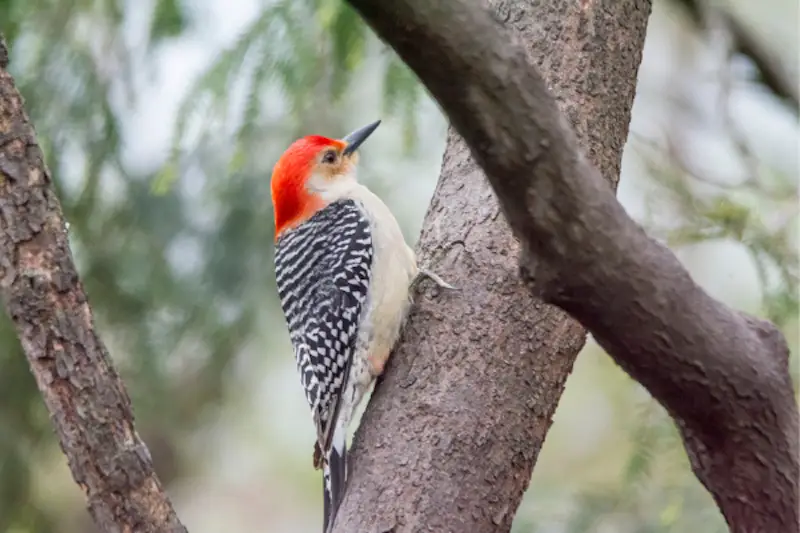
The Red-bellied Woodpecker has a black-and-white “Zebra” pattern on its back, as well as a white rump.
Males have a red crown that goes all the way down to the base of the neck. Both sexes look similar, but the female lacks the bright cap on its head.
This woodpecker favors shady woodlands, forest edges and backyards with old trees.
During winter, this small red headed bird stores berries and acorns in tree crevices and cracks. Every year, the Red-bellied Woodpecker excavates a new nest below the previous one in the same tree.
Acorn Woodpecker
Scientific name: Melanerpes formicivorus
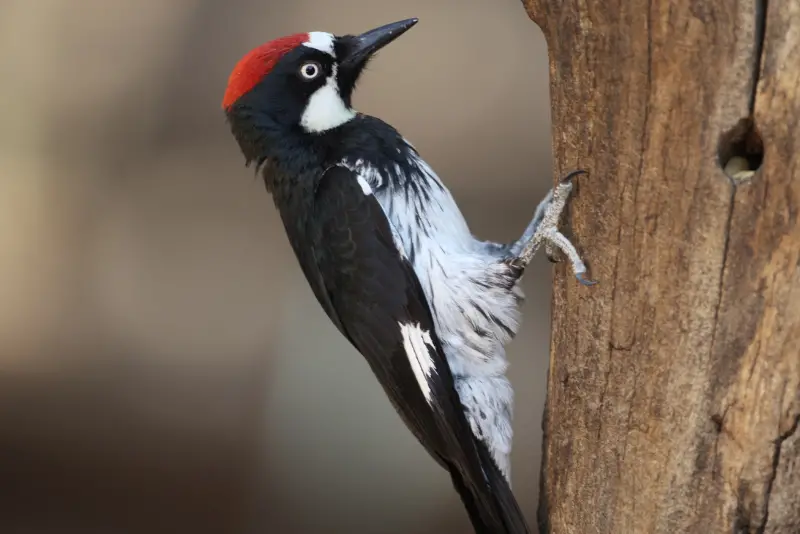
The Acorn Woodpecker is a colorful small woodpecker that only occurs in a few areas of the southwestern and western United States.
While the back and wings of these birds are largely black, their face has a large white patch on the throat and forehead, while the belly is white with black spots.
In addition to their black plumage, both sexes also have a bright red patch on top of their head, and they are usually observed as part of a social group that forages together for acorns in open oak forests.
They store their acorns in trees that are riddles with small holes created by a group of Acorn Woodpeckers. These birds also nest communally, and cooperate in raising their young.
Red-breasted Sapsucker
Scientific name: Sphyrapicus ruber
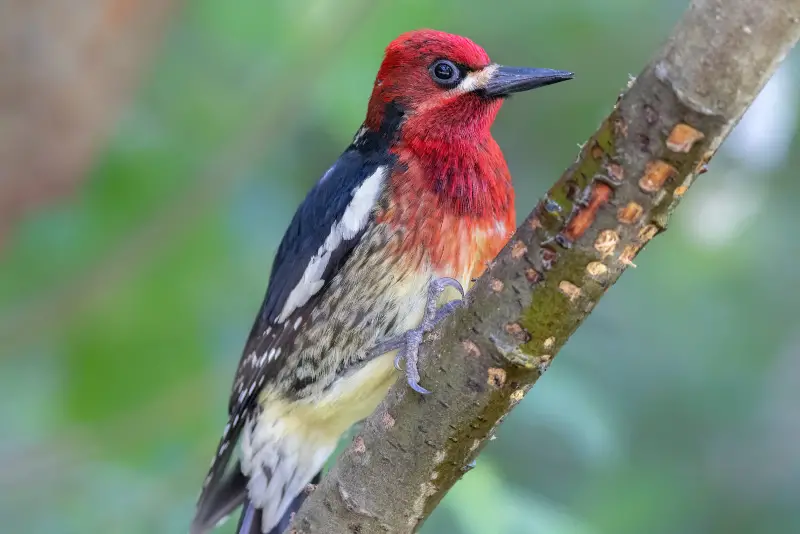
The Red-breasted Sapsucker is a striking member of the woodpecker family, due to the scarlet head and breast of adult birds.
The back is dark brownish black, while the belly is cream colored with dark spots and streaks. Juvenile birds look similar, but lack most of the red coloration.
Red-breasted Sapsuckers are birds of westernmost North America, and occur in a band along the coast from southern California all the way up to southern Alaska.
They are regular breeding birds in mixed forests, and can also be encountered in other habitats during winter, when there is an influx of northern sapsuckers that migrate to the United States for the winter.
Red-naped Sapsucker
Scientific name: Sphyrapicus nuchalis
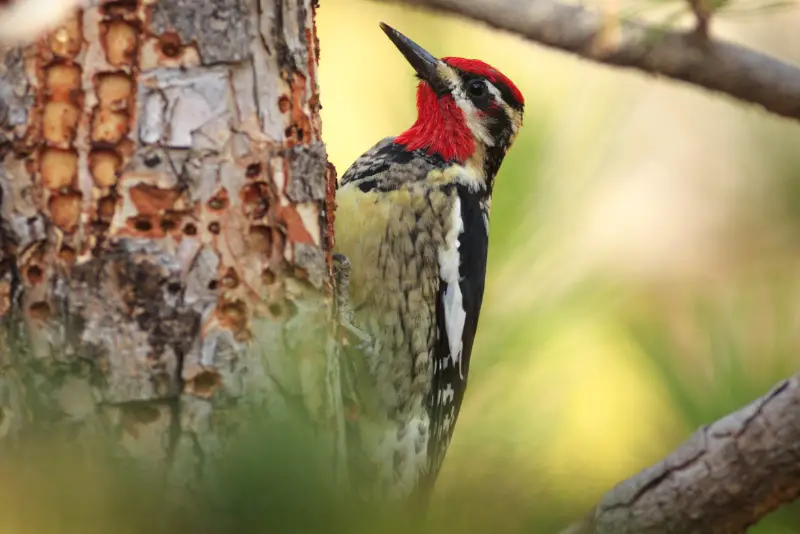
The Red-naped Sapsucker is a small woodpecker species with striking red coloration on the head.
The partially scarlet coloration of their head makes it easy to tell them apart from Red-breasted Sapsuckers, which have completely red colored heads.
This sapsucker is a breeding bird in the mountains of North America, but is more common during the winter months, when there is an influx of wintering birds from Canada.
Pine Grosbeak
Scientific name: Pinicola enucleator

The Pine Grosbeak is a red songbird with black wings and a short and stubby bill.
The adult males are raspberry red with varying amounts of gray on their sides and bellies. The tail and the wings are black with two white wing bars.
This red and black bird breeds in the mountainous regions of North America, where it is a year-round resident.
Masked Crimson Tanager
Scientific name: Ramphocelus nigrogularis
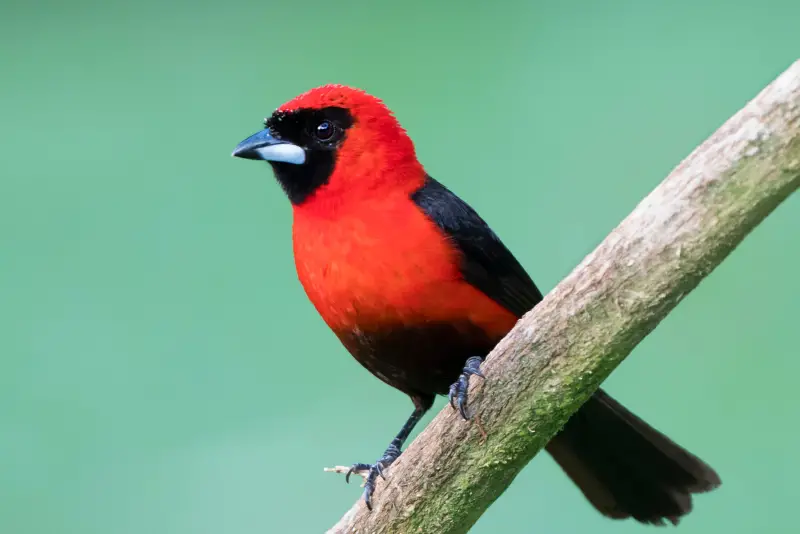
The Masked Crimson Tanager is a stunningly beautiful tropical bird found in the rainforests of northern South America.
And while this is not a North America bird, we decided to include it in this article since it does show up in the southern United States as a rare vagrant.
It’s easy to identify this bird, due to its crimson red and black plumage. Females look similar to males, but are slightly more drab.
Another great distinguishing feature is its silver colored lower bill, which contrasts with the black mask.
Crimson-collared Tanager
Scientific name: Ramphocelus sanguinolentus
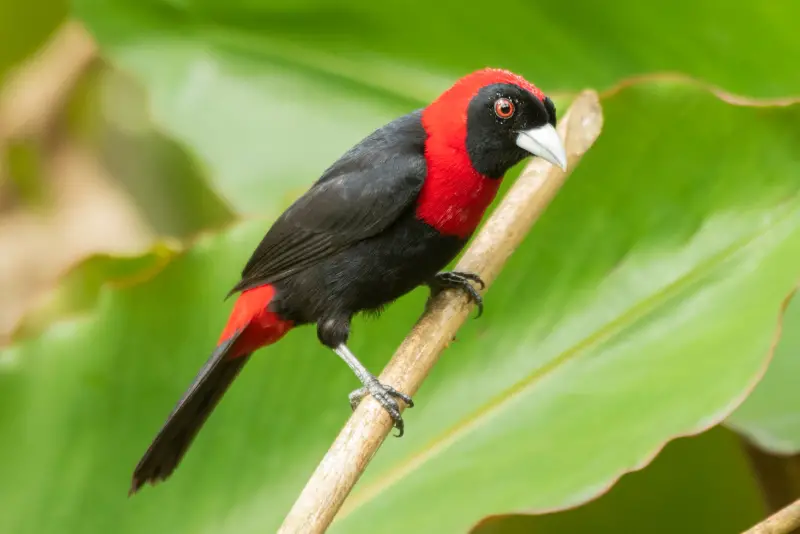
The Crimson-collared Tanager is a breeding bird of Mexico and Central America, but is spotted as a regular vagrant in southern Texas.
It is a bird of evergreen tropical rainforests, where it is most often observed foraging at the edges of clearings and along rivers.
The sexes resemble each other, and pairs are usually observed foraging together.
This bird can be distinguished from the Masked Crimson Tanager by its entirely silver bill, while only the lower bill is silver in the latter species.
Final remarks
In summary, here are the 15 types of birds in North America that have a combination of black and red feathers:
- Northern Cardinal
- Scarlet Tanager
- Red-headed Woodpecker
- Rose-breasted Grosbeak
- Red-winged Blackbird
- Tricolored Blackbird
- Pileated Woodpecker
- Red-bellied Woodpecker
- Acorn Woodpecker
- Red-breasted Sapsucker
- Red-naped Sapsucker
- Vermilion Flycatcher
- Pine Grosbeak
- Masked Crimson Tanager
- Crimson-collared Tanager
If you’ve spotted one of these birds while bird watching in your backyard, hopefully this ID guide will help you identify it quickly and easily.
And if you enjoyed this article, check out our guide to the black birds with white spots.
